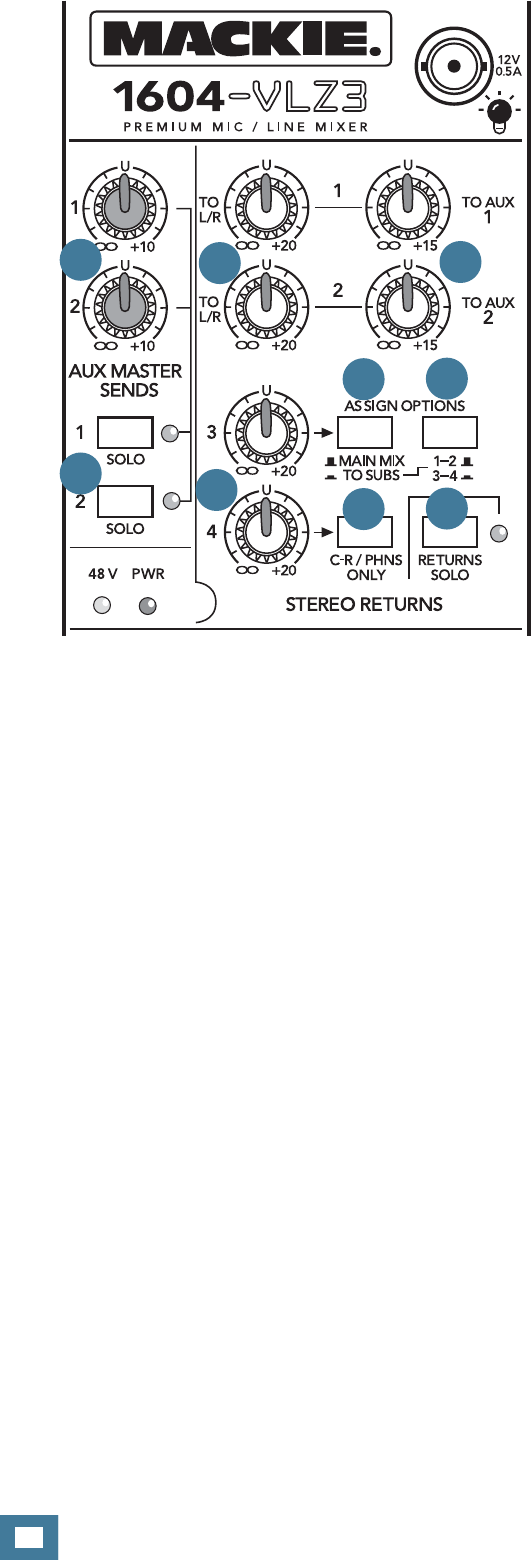
24
1604-VLZ3
1604-VLZ3
52. TO AUX 1 and TO AUX 2
If you want to add reverb or delay to the stage monitor
mixes, these are the knobs for you. Operating indepen-
dently of their respectively numbered STEREO RE-
TURNS [51] level controls, these knobs are exactly the
same as the channel strip AUX 1 [34] and AUX 2 knobs.
These two knobs feed stereo return signals to their
respective AUX SEND [6] outputs:
TO AUX SEND 1 feeds STEREO RETURN 1 to AUX
SEND 1 master, and:
TO AUX SEND 2 feeds STEREO RETURN 2 to AUX
SEND 2 master.
They are off when turned fully down, deliver unity
gain at the center detent, and can provide up to 15 dB of
gain turned fully up. STEREO RETURN 3 and 4 have no
such knobs.
53. MAIN MIX TO SUBS (STEREO RETURN 3)
With this switch up, STEREO RETURN 3 behaves like
all the others — it delivers a stereo signal, regulated
by its level knob, to the main mix. When you engage
this switch, the signals are removed from the main mix
buses and sent to the 1-2/3-4 switch, which diverts the
signal once more. We’re not fi nished. Please read on.
54. 1–2/3–4 (STEREO RETURN 3)
If the MAIN MIX TO SUBS [53] switch is disengaged,
this switch does absolutely nothing. Let’s now assume
it’s engaged. STEREO RETURN 3’s stereo signal will not
be sent to the main mix, but to subgroup faders 1 and 2
(this switch up) or subgroup faders 3 and 4 (this switch
down).
Let’s say you’ve made a stereo drum submix on sub-
group faders 1 and 2, so you can ride those two faders
instead of the seven channels that the drums came
from. Subgroup fader 1 has its ASSIGN TO MAIN MIX
[39], LEFT button engaged and subgroup fader 2 has its
ASSIGN TO MAIN MIX, RIGHT button engaged, blend-
ing the drum submix back into the main mix. The drum
channels are also sending signals to your reverb via the
AUX SENDS [6], and the reverb outputs are patched
into STEREO RETURN 3 [7]. So far so good.
Even though you could send STEREO RETURN 3 di-
rectly to the main mix (MAIN MIX TO SUBS [53] switch
up), you don’t want to. Instead, engage the MAIN MIX
TO SUBS switch and make sure the 1–2/3–4 switch is
up. Now the reverb return will be blended into the drum
submix, and as you ride those two faders, the reverb
level will follow.
Why do we want that? Because if you had just sent the
reverb directly to the main mix (MAIN MIX TO SUBS
switch up) and you did a drum fade-out using subgroup
faders 1 and 2, the “dry” signals would fade out, but the
“wet” signals would keep on singing. All you would hear
is the drum reverb (the “wet”), and none of the original
drum signals (the “dry”). That’s because the reverb is
being fed by the channel’s AUX sends, and they have no
idea that you’ve pulled down the subgroup faders. That’s
why we threw in these switches, phew!
51
51
52
53
54
55
56
49
50


















